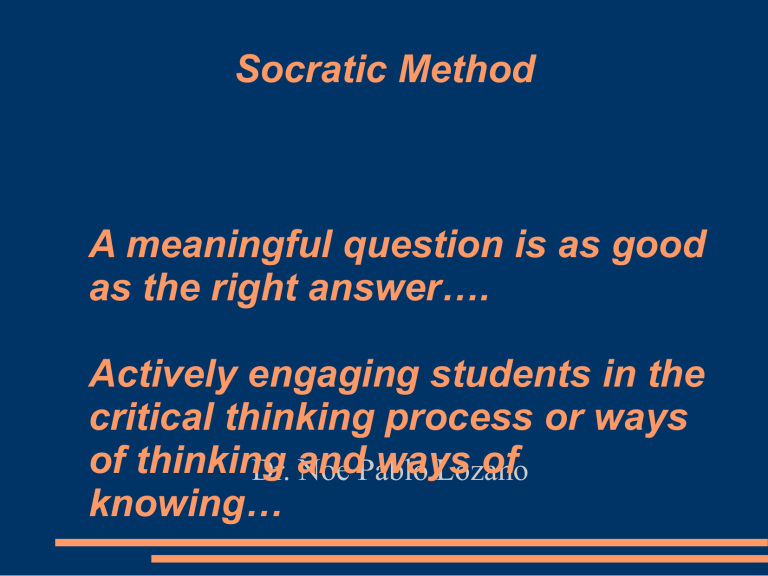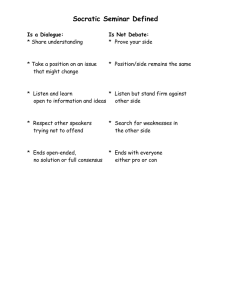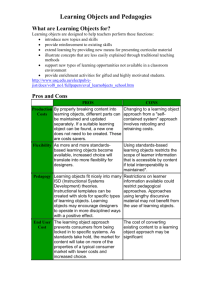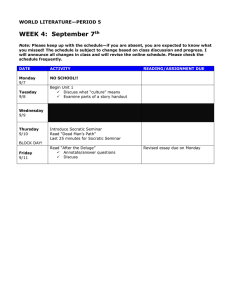
Socratic Method A meaningful question is as good as the right answer…. Actively engaging students in the critical thinking process or ways of thinking ways of Dr. and Noe Pablo Lozano knowing… Outline Socratic Method Definition Key Points Advantages Disadvantages Using the Socratic Method General Guidelines Forming Questions “Techie” Classroom Settings What is the Socratic Method? General: Foundation of Western Pedagogical Tradition. A controlled debate used as a method of inquiry for the examination of conceptual, philosophical, and moral ideas. Teaching: A shared dialogue between teacher and students, where both are responsible for continuing the dialogue through questioning Probing questions by Teachers lead the discussion Questions are asked, by an individual, by the other Students and by the instructor to determine uncertainty, examine complexity and understand difficulty; Teachers are equally participant and a guide or source of knowledge; Open-ended inquiry: lead with or without a lesson plan; the dialogue of teacher/student leads to the new knowledge; Socratic Questioning Fundamental part of the Method Objectives: Examine the student's thoughts: Use to demonstrate complexity, difficulty and uncertainty Learn what is known Learn what is not known Force evaluation of current beliefs Know facts, yet what do students thinks about these facts Strengthen Socratic ability Focus on what specific students thinks and avoid what the World or others think; Encourage questioning self and others Teach how to construct deep, meaningful questions You do not need to know all the knowledge Key Differences Lecturer Students Does not lecture Poses a question, but does not answer Fosters the analysis through Socratic Questions Must listen and actively engage Focus on the underlying principles Account for beliefs in class Ask questions of Lecturer and fellow students Environment of familiarity, yet “productive discomfort” verses intimidation and panic Key Differences Three Way Dialogue with equal status The Individual student contribution The other students’ perspectives The lecturer’s focus and emphasis Effectiveness Advantages Fosters critical thought above memorization Enforces the beliefs of students as ideas are subject to examination Teaches to question, understand, and extend Reveals the complexity of seemingly simple statements Focus students on articulating their values and on their ideas holding up to scrutiny Disadvantages Difficult to apply in certain classroom settings Not as suited for imparting worldly facts and standard lecture Not optimal for imparting logical facts, theorems, and knowledge generated by conventional lectures. Method in Practice Participate in the dialogue Professor and student must be willing to accept new ideas “I don't know” is an acceptable answer for anyone Remove deference to authority Silence is productive Be reasonable (10 seconds) Do not answer questions, rephrase instead Environment for the Method Create the proper environment Learn the names of each person Short interventions, not speeches, when needed Small groups for larger classes Encouraging Thought Alternative positions are acceptable Follow-up on responses Emphasize active participation Forming the Question Ask a single question Concise, clear questions “How are A and B the same, and why are they different”? vs. “Why is A different from B?” Eliminate unnecessary words Easily understood, yet accurate language Ask appropriate kind of question Analysis Comparison Observation In “Techie” Environments Application Classes Seminars for theoretical understanding Substitute for pure lecture may be undesirable Possibility: Schedule “Socratic Seminar” periods with standard lecture Theoretical Classes Seminars can be used to advance the class Teaches required critical thought with the concepts involved Possibility: Focus on extending concepts learned In “Techie” Environments “The unexamined life is not worth living” Equally True: “The unexamined problem set is not worth doing.” How many questions do you need to ask yourself in order to optimize your learning for each class? Focus is on content and principals and not personal narratives…


